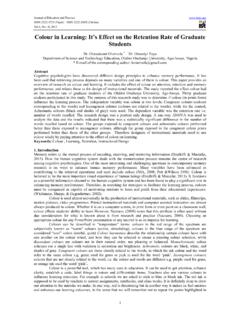Transcription of Colour vision examination - HSE
1 GN. Colour vision examination A guide for occupational health providers Guidance Notes are published under five subject Guidance Note MS7 (Third edition). headings: This guidance is issued by the Health and Safety Executive. Medical Following the guidance is not compulsory and you are free Environmental Hygiene to take other action. But if you do follow the guidance you will normally be doing enough to comply with the law. Chemical Safety Health and safety inspectors seek to secure compliance Plant and Machinery with the law and may refer to this guidance as illustrating good practice.
2 General 1 This document acts as an aid to employers and their three. Alternatively, although all three photopigments are occupational health providers in choosing the appropriate present, there may be abnormal spectral sensitivity Colour vision testing methods given the risks involved in (anomolous trichromatism). the occupation. The incidence of Colour vision defects constitutes approximately 8% of the male population for Monochromats both inherited defects and a similar number for acquired defects, especially in those over 45 years of age.
3 3 Monochromats are individuals who have single-cone Employers and occupational health providers should also photopigment-type cells, or no functioning cone cells at realise the importance of using a risk assessment-based all. Visual acuity (sharpness) is poor and and this type of approach when deciding what the pass/fail criteria is for Colour vision defect is usually identified in early adulthood. employing a person, where Colour vision is a requirement Colour discrimination is not possible and people are truly of their employment.
4 This should be decided before Colour blind, seeing everything in shades of grey and starting any Colour vision testing procedure. Occupational white. The incidence of this defect is very rare for both health providers may find it useful to read this document inherited and acquired defects. alongside Colour vision examination : A guide for If an employer has employees whose Colour Dichromats and anomalous trichromats vision is important for safety-critical purposes, then Colour vision testing is crucial in deciding on their fitness for 4 Dichromats are deficient in one of the three Colour work.
5 However in companies where Colour vision needs receptor mechanisms, due to a cone Colour pigment are not associated with safety-critical systems but with deficiency. There are three types of dichromatic Colour product quality, Colour vision testing is valuable to avoid deficiency, protanopia (red), deutanopia (green) and costly errors. tritanopia (blue), depending on which of the three photopigments is affected. Protan and deutan defects are TYPES OF Colour vision DEFECT known collectively as red-green Colour deficiency.
6 Anomalous trichromatism is where the spectral sensitivity 2 Retinal cone cells contain three classes of of one of the three Colour receptor mechanisms is altered. photopigment that have maximum sensitivity in the long- This defect is seen in both acquired and inherited subjects wavelength (red), middle-wavelength (green) and short- and there is a wide spectrum of severity. The classification wavelength (blue) parts of the visual spectrum. In those system and terms used are shown in Table 1. with normal Colour vision , this is referred to as normal trichromacy.
7 Inherited Colour deficiency arises from inherited cone photopigment abnormalities. There may only be one photopigment (monochromatism) or two photopigments (dichromatism) in the retina instead of 1 of 7. Table 1: Terms used to describe dichromats and anomalous trichromats Protan defects: Deutan defects: Abnormalities of Tritan defects: Abnormalities Abnormalities of the the green-sensitive of the blue-sensitive red-sensitive photopigment photopigment photopigment Tritanopia. Dichromatism Protanopia Deuteranopia Rare for inherited.
8 Common for acquired Anomalous Protanomalous Deuteranomalous trichromatism Tritanomalous trichromatism trichromatism trichromatism Colour genetics Characteristics of Colour deficiency 5 Genes that specify the red- and green-sensitive 7 As Colour -deficient people can only see a limited photopigments are located on the X chromosome and number of colours, their ability to differentiate by Colour is abnormalities are inherited as an X-linked recessive trait. restricted. This means mistakes can be made in Colour This results in a much higher prevalence of red-green identification and some colours are confused.
9 People with Colour deficiency in men than in women. The most usual significant Colour deficiency (dichromats and severe transmission is from maternal grandfather to grandson, anomalous trichromats) confuse bright colours in all through the woman as carrier with one X chromosome viewing conditions, whereas people with slight Colour affected. A woman will only have Colour deficiency if both deficiency typically confuse pale or dark colours. The of her X chromosomes carry similar abnormal genes; range of Colour confusions increases in low-level hence there is a much lower prevalence of inherited illumination and if the coloured areas are small.
10 Colour deficiency among females. Brothers of Colour -deficient confusions for acquired defects are unpredictable and the men have a 50% chance of being similarly affected. The Colour perception of such people is often unstable. different types of red-green Colour deficiencies do not occur with the same frequency. Deuteranomalous 8 The relative luminance (brightness and contrast) of trichromatism is the most common type. colours is altered in some types of Colour deficiency. Protans, especially protanopes, are particularly Table 2: Prevalence of different types of inherited red- disadvantaged in practical tasks because reds look dark green Colour deficiency and may be confused with black.















